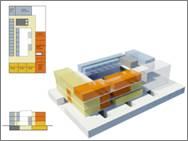History
Downtown Campus
Downtown Campus (both the Academic campus and the Alumni quadrangle) is eligible for listing on the National Register of Historic Places.
- Under Criterion A for its association with historic events
- Both the downtown academic campus and the residential quad are historically significant for their association with the expansion of the State Normal School system in the early-20th century and again in the 1920s and 1930s.
- Alumni Quad was built by the Alumni Association to meet the demand for student housing.
- Alumni Quad’s Pierce and Sayles were constructed first. Matching the first two in style and scale, Brubacher, Alden and Waterbury Halls were later constructed to complete the symmetrical unified composition of the courtyard,
- Note: Brubacher, Alden and Waterbury Halls are now considered historic and contributing features to the overall complex because of their age (over 50 years old) and style.
- Under Criterion C for architecture
- Each building is eligible for listing both individually and as a contributing feature to its associated complex.
- Alumni Quad: Intact representative example of a planned Georgian Revival college campus in New York State.
- Downtown Academic Campus: Georgian Revival style unified in composition and scale with Draper and Page Halls as focal points for each of the two U-shaped sets of the three buildings each.
- Alumni Quad and Downtown Academic Campus: All buildings retain a high level of integrity in both architecture and use (Even later additions were carefully designed to reflect the scale, style and decorative details of the earlier buildings).
Uptown Campus
The Uptown Campus is eligible for listing on the National Register of Historic Places.
- Under Criterion A for its association with historic events
- In response to the great increase in the nation’s college enrollment throughout the 1950s, then Governor Nelson A. Rockefeller embarked on a state-wide building campaign that included establishing a major initiative to improve both the quality of education and the physical facilities of the state university system, which ultimately resulted in the development of the UAlbany Uptown campus.
- By the end of his tenure, he increased the system from 29 campuses & 38,000 students to 72 campuses and 232,000 full-time students.
- Under Criterion B for its association with the lives of persons significant in our past
- Each building is eligible for listing both individually and as a contributing feature to its associated complex.
- Under Criterion C for architecture (as a complex), method of construction, work of a master, and represents a significant and distinguishable entity.
- Mid-Century Modern style
- Schokbeton concrete process, a patented, innovative foreign fabrication technique, yet unknown at that time
- Architect: Edward Durell Stone (also known for Kennedy Center for the Performing Arts and the National Geographic Society, both in Washington, D.C., and NYC’s Museum of Modern Art, among many others); he was greatly inspired by Frank Lloyd Wright and was known for pioneering the New Formalism architectural movement.
- The original University at Albany campus, as a complex consisting of over 60 contributing features (buildings, sites, structures, and objects) is a unique, intact example of this architectural style, of this magnitude, in this country, by this architect. Only other larger complexes exist in Pakistan and India.
A comprehensive and contextual history can be found on pp.13-65 of the Campus Heritage Preservation Plan







